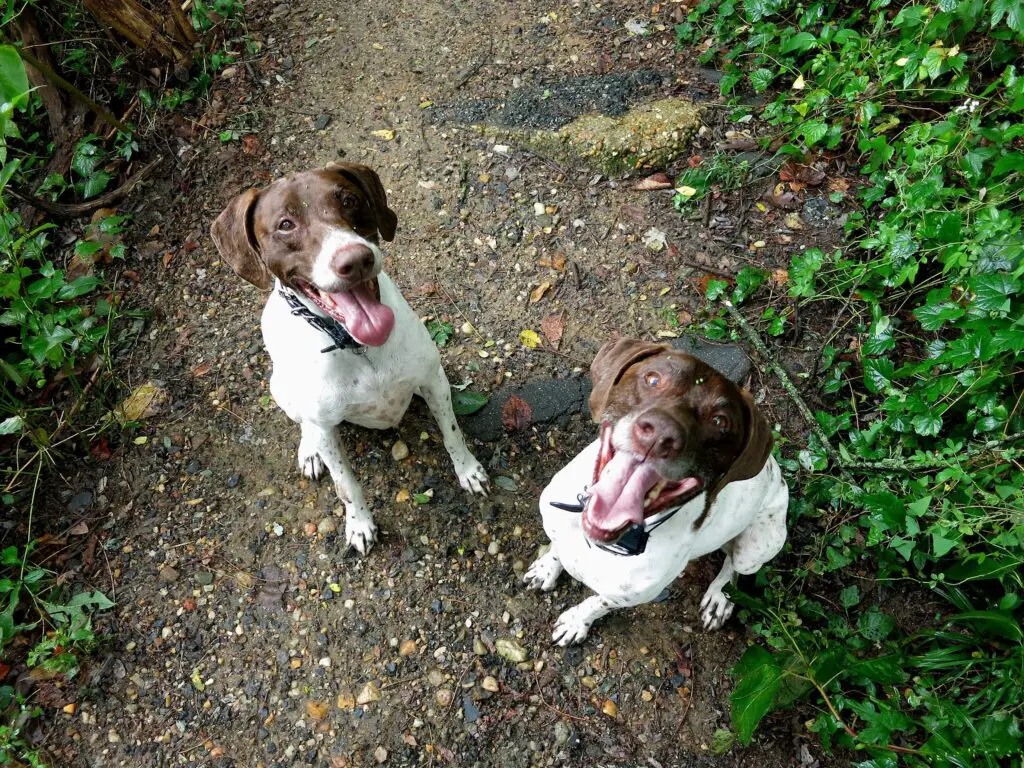Service dogs can help with physical tasks, such as providing balance support, retrieving dropped items, and opening doors. They can also fulfill emotional tasks such as alerting their owners to anxiety attacks or providing comfort during a panic attack.
In other words, they’re specially trained dogs that perform various tasks to assist people with disabilities. However, can every dog be a service animal? Can German Shorthaired Pointers make good service dogs?
They’re hunting dogs used for pointing and retrieving games with friendly, outgoing, and energetic personalities.
The best part? They’re intelligent and easily trained, but would they make good service dogs? Some experts suggest whether a dog can become a service dog depends on many factors.
We will discuss those factors below, so let’s dive right in.
Can GSPs Be Service Animals?
German Shorthaired Pointers have the potential to make good service dogs, as they are intelligent, energetic, and easily trained.

However, not all dogs, even within a specific breed, have the right temperament and skills to become service dogs.
Service dogs need to be able to focus on their handler and perform tasks consistently, even in distracting environments. They also need to be calm, well-behaved, and able to handle the physical and emotional demands of the job.
A German Shorthaired Pointer who has been properly trained and tested for suitability can be a great service dog.
That’s why you should work with a reputable service dog organization to ensure the dog receives the proper training and certification needed to perform as a service dog.
Can Pointers Be Therapy Dogs?
Pointers, including German Shorthaired Pointers, can be therapy dogs. These dogs visit hospitals, nursing homes, schools, and other facilities to provide comfort and affection.
To become a therapy dog, the dog must have a friendly personality. Moreover, it should behave well in public settings.
Emotional support dogs must be trained to act appropriately in different environments and hang out with different types of people. The training requirements vary depending on the therapy dog organization.
However, they typically involve basic obedience training and socialization. In summary, if a Pointer has the right temperament and is properly trained, it can make a perfect emotional support dog.
What Makes a Good Service Dog?
To be considered a service dog, the dog must be individually trained to perform specific tasks. A good service dog should have several key characteristics, including:
Temperament
Service dogs should have a calm and stable temperament. Moreover, they should feel confident in various environments and focus on their handler.
Training
These dogs must be trained to perform specific tasks related to their handler’s disability and be able to perform these consistently in various settings.
Physical Ability
Service dogs should be in good health and physical condition and able to perform their duties physically.
Good Behavior
Service dogs should have good manners and act well in public settings. Moreover, they should be able to remain calm and focused in distracting environments.
Reliability
These canines should perform their tasks reliably and consistently, even in challenging situations.
Affection
Service dogs should have a strong bond with their handler and be affectionate towards them. Remember, not all dogs can perform service work.
Moreover, working with a reputable organization is crucial to ensure a dog has the necessary skills and temperament to be a successful service canine.

Different Types of Service Dogs
Here’s a list of different types of service dogs:
- Guide dogs: Help people who are blind or have low vision navigate their environment
- Hearing dogs: Assist people who are deaf or hard of hearing by alerting them to various sounds
- Mobility assistance dogs: Assist people with mobility impairments, such as those using wheelchairs or with limited dexterity, by performing tasks such as retrieving dropped items, opening doors, and providing balance support
- Medical alert dogs: Alert their handlers to various medical conditions such as low blood sugar levels, seizures, or impending migraines
- Psychiatric service dogs: Assist individuals with psychiatric or emotional disabilities, such as PTSD or depression, by performing tasks such as interrupting self-harming behaviors or providing comfort during a panic attack
- Autism service dogs: Assist individuals with autism by providing comfort, safety, and support in social or public settings
Each service dog receives special training for their handler’s needs and disabilities, but not all service canines are recognized or protected under The Americans with Disabilities Act (ADA).
Can Any Breed Be Service Dogs?
Not all dog breeds can be service dogs because these dogs receive special training, which includes performing tasks for people with disabilities, and unfortunately, not every breed has the physical and temperamental traits for this type of work.
The best service dogs include Labrador Retrievers, Golden Retrievers, and German Shepherds. Mixed-breed dogs can also be good service dogs with the right temperament, trainability, and physical characteristics.
Does the Sex and Size of the Dog Matter?
The sex and size of the dog can matter for service work. However, the most important factor is the individual dog’s temperament, trainability, and physical abilities.
Sex
There’s no significant difference between male and female dogs regarding suitability for service work. However, spayed and neutered canines may be easier to train because they’re typically calmer.
Size
The size can impact a dog’s suitability for certain tasks, such as mobility assistance for someone with balance issues or physical limitations.
Small dogs may have difficulty performing tasks that require strength, while larger dogs may have trouble fitting in tight spaces or maneuvering in small spaces.
7 Things To Know Before Getting a Service Dog
Here’s a list of important things to consider before getting a service dog:
1. Purpose
Clearly define the tasks you need your service dog to perform and make sure they’re specific, measurable, and realistic.
2. Training
Service dogs require extensive training and ongoing socialization to perform their tasks effectively. So, consider professional training programs or hiring a certified trainer.
3. Cost
Remember that the cost of getting and maintaining a service canine can be high, including training, equipment, food, and veterinary care expenses.
4. Time Commitment
Raising and training a service canine takes significant time and effort, so prepare for a challenging, long-term commitment.

5. Legal Considerations
Service dogs are protected by the Americans with Disabilities Act (ADA), but you must meet specific guidelines and requirements.
Therefore, make sure you understand your rights and responsibilities under the ADA.
6. Suitability
Not everyone is suited to having a service dog, and not all canines can become service dogs.
7. Support
Raising and training a service canine can be challenging. So, it’s important to have a support network, including a veterinarian, a professional trainer, and a support group for service dog handlers.
Final Tips
We will wrap this article with specific steps on obtaining a service dog for people who don’t know how the process goes.
Here’s a list of steps you should follow:
- Determine if you have a disability that qualifies you for a service dog according to the Americans with Disabilities Act (ADA).
- Research and choose a reputable service dog organization. Look for one that trains dogs for the specific task you need.
- Apply to the organization and provide documentation of your disability if required.
- Participate in a matching process to find the right dog for you.
- Complete the training process.
- Register your service canine and carry proper identification, such as a vest or ID card, when in public.
Lastly, remember that service dogs can be expensive, so be prepared to pay a fee to cover the costs.


